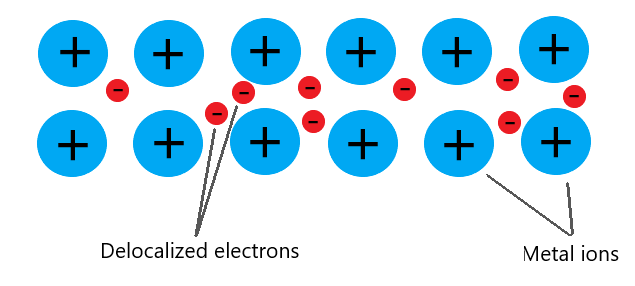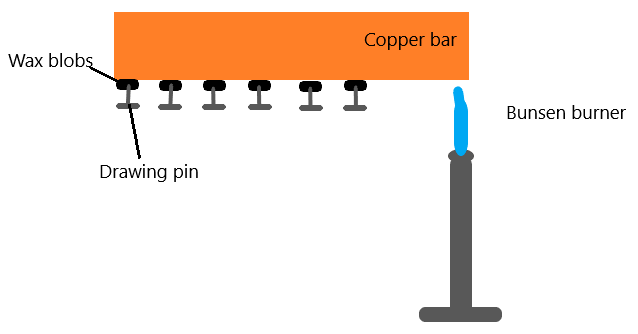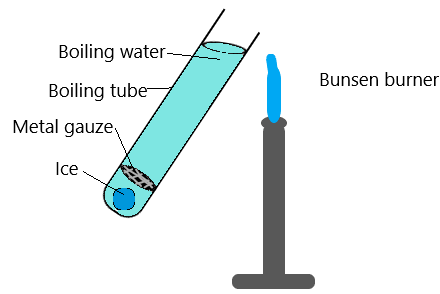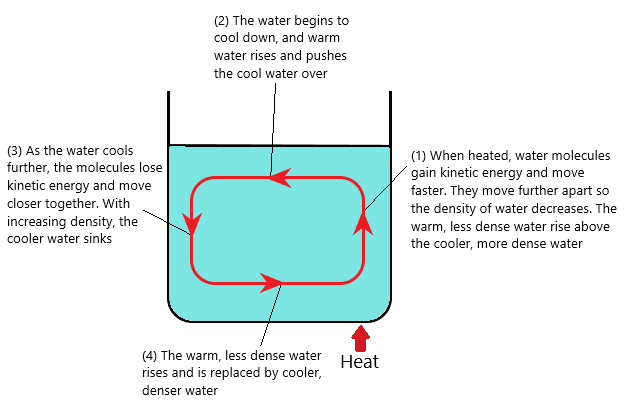Conduction
Conduction is the process by which heat or electricity is directly transmitted through the material of a substance
Some substances (such as metals) are much better conductors than other substances.
Good conductors
The metallic structure is composed of a lattice of metal ions (atoms that have lost their outer electrons), and a sea of ‘free electrons’ that move throughout the structure.

When one end of a metal is heated, the metallic ions gain energy and vibrate faster. Since ions are close together, vibrations are passed onto neighboring ions which in turn, begin to vibrate quicker too. Through the passage of kinetic energy in the form of vibrations, heat is transferred from the hot end to the cold end.
Metals also have free electrons that gain kinetic energy at the hot end of the metal. These free electron are highly mobile and can pass on their kinetic energy via collisions with other electrons and metal ions as they randomly move throughout the structure. This greatly enhances the conduction process as energy is transmitted much quicker from one end to the other.
The presence of free electrons is the main reason why metals are great conductors.
An experiment can be conducted to show that copper is indeed a good conductor of heat. Consider this set-up:

As the copper bar is heated at one end, the drawing pins will fall off one by one (from the one closet to the bunsen burner). This is because the metal conducts heat from the hot end to the cold end, and in doing so, melts the blobs of wax.
Poor conductors (insulators)
Water, like other liquids and non-metallic solids, are poor conductors of heat. Materials that are very poor conductors are known as insulators i.e. rubber
The absence of free electrons mean that molecules cannot easily pass on kinetic energy to their neighbors, so heat can only be transmitted through particle vibrations and collisions.
The absence of free electrons is the reason why materials are poor conductors
An experiment can be conducted to demonstrate that water is a poor conductor of heat. Consider this experimental set-up:

As the water at the top of the boiling tube is heated, it eventually boils. Despite that, the ice at the bottom of the tube does not melt. This demonstrates that the heat is not reaching the bottom of the tube, and therefore that water is a poor conductor.
If we changed the set-up, and the ice cube was floating at the top of the tube and heat was applied at the bottom, then the ice would melt easily. This is because water can be heated via convection.
Convection
Convection is an important method of heat transfer in liquids and gases.

Radiation
Infra-red radiation is a part of the electromagnetic spectrum, and is emitted by any hot object.
Unlike convection and conduction, where particles are required to transmit the heat, infra-red radiation can travel across vacuum. In other words, it does not need a medium for transmission.
This is why we can feel that heat from the sun. There are no particles in vacuum (space), yet the heat makes its way to us from the sun through space.
Infra-red radiation can be emitted, absorbed, or reflected.
Experiment to demonstrate which type of surface is the best emitter of infra-red radiation
Set-up & procedure
- A metal cube with is painted with 4 different types of surfaces: matt black, shiny black, white and silver
- The cube is filled with boiling water
- A heat detector is placed at a constant distance away from the cube i.e. 50cm
- The cube is rotated so that each side faces the heat detector in turn, and the readings are noted
Results (in order of emission levels)
- Matt black (highest) -> Shiny black -> White -> Silver (lowest)
Experiment to demonstrate which type of surface is the best absorber of infra-red radiation
Set-up & procedure
- A radiant heater is placed in the middle of two plates at equal distance away from the heater
- One plate is matt black and the other is silver
- A thermometer is placed on each plate and initial reads of the thermometers are recorded
- The heater is switched on and the temperatures of each of the plates are measured in equal intervals
Results:
- The temperature of the matt black plate will increase quicker than the silver
- Matt black surfaces are therefore better absorbers of radiation